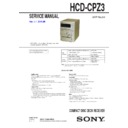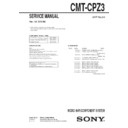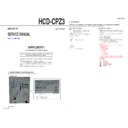Sony CMT-CPZ3 / HCD-CPZ3 Service Manual ▷ View online
SERVICE MANUAL
Sony Corporation
Published by Sony Techno Create Corporation
HCD-CPZ3
SPECIFICATIONS
COMPACT DISC DECK RECEIVER
9-889-750-02
2011E05-1
©
2011.05
AEP Model
Ver. 1.1 2011.05
• HCD-CPZ3 is the amplifi er, CD player, tape deck
and tuner section in CMT-CPZ3.
CD
Section
Model Name Using Similar Mechanism
HCD-CPZ1
CD Mechanism Type
CDM80BH-F1BD83
Base Unit Name
BU-F1BD83
Optical Pick-up Name
KSM-215DCP
TAPE
Section
Model Name Using Similar Mechanism
HCD-CPZ1
Tape Transport Mechanism Type
CMAL1Z236 or
CRP42613
US and foreign patents licensed
from Dolby Laboratories
Amplifier section
DIN power output (rated): 60 W + 60 W (4 ohms at 1 kHz, DIN)
Continuous RMS power output (reference): 75 W + 75 W (4 ohms at 1 kHz,
10% THD)
Outputs
Continuous RMS power output (reference): 75 W + 75 W (4 ohms at 1 kHz,
10% THD)
Outputs
CD DIGITAL OUT: Optical Wavelength: 660 nm
PHONES (stereo mini jack): Accepts headphones with an impedance of 8
ohms or more
SPEAKER: Accepts impedance of 4 ohms
PHONES (stereo mini jack): Accepts headphones with an impedance of 8
ohms or more
SPEAKER: Accepts impedance of 4 ohms
CD player section
System: Compact disc and digital audio system
Laser Diode Properties
Laser Diode Properties
Emission Duration: Continuous
Laser Output*: Less than 44.6 μW
* This output is the value measurement at a distance of 200 mm from the
Laser Output*: Less than 44.6 μW
* This output is the value measurement at a distance of 200 mm from the
objective lens surface on the Optical Pick-up Block with 7 mm aperture.
Frequency response: 20 Hz
20 kHz (±1 dB)
Wavelength: 770 nm
810 nm
Tape deck section
Recording system: 4-track 2-channel, stereo
Tuner section
FM stereo, FM/AM superheterodyne tuner
FM tuner section:
Tuning range: 87.5 MHz
108.0 MHz (50 kHz step)
Antenna: FM lead antenna
Antenna terminals: 75 ohms unbalanced
Intermediate frequency: 10.7 MHz
Antenna terminals: 75 ohms unbalanced
Intermediate frequency: 10.7 MHz
AM tuner section:
Tuning range: 531 kHz
1,602 kHz (9 kHz step)
Antenna: AM loop antenna
Antenna terminals: External antenna terminal
Intermediate frequency: 450 kHz
Antenna terminals: External antenna terminal
Intermediate frequency: 450 kHz
General
Power requirements: 230 V AC, 50/60 Hz
Power consumption: 60 watts
Dimensions (w/h/d) (excl. speakers): Approx. 175 mm × 240 mm × 295 mm
Mass (excl. speakers): Approx. 3.8 kg
Power consumption: 60 watts
Dimensions (w/h/d) (excl. speakers): Approx. 175 mm × 240 mm × 295 mm
Mass (excl. speakers): Approx. 3.8 kg
Design and specifications are subject to change without notice.
Note: Tape mechanical deck has been changed in the midway of production.
Refer to “SUPPLEMENT-1” for details.
HCD-CPZ3
2
1.
SERVICING NOTES
............................................. 3
2. DISASSEMBLY
2-1. Disassembly Flow ........................................................... 4
2-2. Case .................................................................................
2-2. Case .................................................................................
5
2-3. Front Panel Block ........................................................... 5
2-4. TC Board, Mechanical Deck .......................................... 6
2-5. PANEL Board ................................................................. 7
2-6. MAIN Board ................................................................... 7
2-7. CD Mechanism Deck (CDM80BH-F1BD83) ................ 8
2-8. Chassis (Top) .................................................................. 8
2-9. Lever (Loading-L/R) ....................................................... 9
2-10. Lever (Disc Sensor), Lever (Disc Stop) .......................... 10
2-11 DRIVER Board, Motor Assy (Loading) (M701) ............ 10
2-12. BD Board ........................................................................ 11
2-13. BU Section ...................................................................... 11
2-14. Optical Pick-up Block (KSM-215DCP) ......................... 12
2-15. Lever (BU Lock) ............................................................. 12
2-16. Close Lever ..................................................................... 13
2-17. Lever (DIR), Gear (IDL-B) ............................................ 13
2-18. Gear (IDL-C) .................................................................. 14
2-4. TC Board, Mechanical Deck .......................................... 6
2-5. PANEL Board ................................................................. 7
2-6. MAIN Board ................................................................... 7
2-7. CD Mechanism Deck (CDM80BH-F1BD83) ................ 8
2-8. Chassis (Top) .................................................................. 8
2-9. Lever (Loading-L/R) ....................................................... 9
2-10. Lever (Disc Sensor), Lever (Disc Stop) .......................... 10
2-11 DRIVER Board, Motor Assy (Loading) (M701) ............ 10
2-12. BD Board ........................................................................ 11
2-13. BU Section ...................................................................... 11
2-14. Optical Pick-up Block (KSM-215DCP) ......................... 12
2-15. Lever (BU Lock) ............................................................. 12
2-16. Close Lever ..................................................................... 13
2-17. Lever (DIR), Gear (IDL-B) ............................................ 13
2-18. Gear (IDL-C) .................................................................. 14
3.
TEST MODE
............................................................. 15
4.
MECHANICAL ADJUSTMENTS
....................... 16
5.
ELECTRICAL ADJUSTMENTS
......................... 17
6. DIAGRAMS
6-1. Block Diagram
– CD SERVO/TAPE DECK/TUNER Section – ............. 18
6-2. Block Diagram – MAIN Section – ................................. 19
6-3. Block Diagram
6-3. Block Diagram
– PANEL/KEY/POWER SUPPLY Section – ................. 20
6-4. Printed Wiring Board – BD Board – ............................... 22
6-5. Schematic Diagram – BD Board – ................................. 23
6-6. Printed Wiring Board – TC Board – ............................... 24
6-7. Schematic Diagram – TC Board – .................................. 25
6-8. Printed Wiring Board – DRIVER Board – ..................... 26
6-9. Schematic Diagram – DRIVER Board – ........................ 26
6-10. Printed Wiring Board – MAIN Board – .......................... 27
6-11. Schematic Diagram – MAIN Board (1/2) – .................... 28
6-12. Schematic Diagram – MAIN Board (2/2) – .................... 29
6-13. Schematic Diagram – AMP Board (1/2) – ...................... 30
6-14. Schematic Diagram – AMP Board (2/2) – ...................... 31
6-15. Printed Wiring Board – AMP Board – ............................ 32
6-16. Printed Wiring Board – SP Board – ................................ 33
6-17. Schematic Diagram – SP Board – ................................... 33
6-18. Printed Wiring Board – LCD Board – ............................ 34
6-19. Schematic Diagram – LCD Board – ............................... 35
6-20. Printed Wiring Boards – PANEL Section – .................... 36
6-21. Schematic Diagram – PANEL Section – ........................ 37
6-22. Printed Wiring Boards – JACK Section – ...................... 38
6-23. Schematic Diagram – JACK Section – ........................... 39
6-24. Printed Wiring Board – SW POWER Board – ............... 40
6-25. Schematic Diagram – SW POWER Board – .................. 41
6-26. Printed Wiring Board – SUB POWER Board – ............. 42
6-27. Schematic Diagram – SUB POWER Board – ................ 43
6-5. Schematic Diagram – BD Board – ................................. 23
6-6. Printed Wiring Board – TC Board – ............................... 24
6-7. Schematic Diagram – TC Board – .................................. 25
6-8. Printed Wiring Board – DRIVER Board – ..................... 26
6-9. Schematic Diagram – DRIVER Board – ........................ 26
6-10. Printed Wiring Board – MAIN Board – .......................... 27
6-11. Schematic Diagram – MAIN Board (1/2) – .................... 28
6-12. Schematic Diagram – MAIN Board (2/2) – .................... 29
6-13. Schematic Diagram – AMP Board (1/2) – ...................... 30
6-14. Schematic Diagram – AMP Board (2/2) – ...................... 31
6-15. Printed Wiring Board – AMP Board – ............................ 32
6-16. Printed Wiring Board – SP Board – ................................ 33
6-17. Schematic Diagram – SP Board – ................................... 33
6-18. Printed Wiring Board – LCD Board – ............................ 34
6-19. Schematic Diagram – LCD Board – ............................... 35
6-20. Printed Wiring Boards – PANEL Section – .................... 36
6-21. Schematic Diagram – PANEL Section – ........................ 37
6-22. Printed Wiring Boards – JACK Section – ...................... 38
6-23. Schematic Diagram – JACK Section – ........................... 39
6-24. Printed Wiring Board – SW POWER Board – ............... 40
6-25. Schematic Diagram – SW POWER Board – .................. 41
6-26. Printed Wiring Board – SUB POWER Board – ............. 42
6-27. Schematic Diagram – SUB POWER Board – ................ 43
TABLE OF CONTENTS
7.
EXPLODED VIEWS
7-1.
Case Sect ion .................................................................... 54
7-2. Mechanical Deck (Tape) Section .................................... 55
7-3. Front Panel Section ......................................................... 56
7-4. Lid (TC) Section ............................................................. 57
7-5. Chassis Section ............................................................... 58
7-6. AMP/Power Section ....................................................... 59
7-7. CD Mechanism Deck Section-1
7-3. Front Panel Section ......................................................... 56
7-4. Lid (TC) Section ............................................................. 57
7-5. Chassis Section ............................................................... 58
7-6. AMP/Power Section ....................................................... 59
7-7. CD Mechanism Deck Section-1
(CDM80BH-F1BD83) .................................................... 60
7-8. CD Mechanism Deck Section-2
(CDM80BH-F1BD83) .................................................... 61
7-9. CD Mechanism Deck Section-3
(CDM80BH-F1BD83) .................................................... 62
7-10. Base Unit Section (BU-F1BD83) ................................... 63
8.
ELECTRICAL PARTS LIST
.............................. 64
NOTES ON CHIP COMPONENT REPLACEMENT
•
•
Never reuse a disconnected chip component.
•
Notice that the minus side of a tantalum capacitor may be dam-
aged by heat.
aged by heat.
FLEXIBLE CIRCUIT BOARD REPAIRING
•
•
Keep the temperature of soldering iron around 270 °C during
repairing.
repairing.
•
Do not touch the soldering iron on the same conductor of the
circuit board (within 3 times).
circuit board (within 3 times).
•
Be careful not to apply force on the conductor when soldering
or unsoldering.
or unsoldering.
SAFETY-RELATED COMPONENT WARNING!
COMPONENTS IDENTIFIED BY MARK
0 OR DOTTED LINE
WITH MARK
0 ON THE SCHEMATIC DIAGRAMS AND IN
THE PARTS LIST ARE CRITICAL TO SAFE OPERATION.
REPLACE THESE COMPONENTS WITH SONY PARTS
REPLACE THESE COMPONENTS WITH SONY PARTS
WHOSE PART NUMBERS APPEAR AS SHOWN IN THIS
MANUAL OR IN SUPPLEMENTS PUBLISHED BY SONY.
MANUAL OR IN SUPPLEMENTS PUBLISHED BY SONY.
This appliance is classi
fi ed as
a CLASS 1 LASER product.
This marking is located on the
rear or bottom exterior.
This marking is located on the
rear or bottom exterior.
CAUTION
Use of controls or adjustments or performance of procedures
other than those speci
Use of controls or adjustments or performance of procedures
other than those speci
fi ed herein may result in hazardous radia-
tion exposure.
Ver. 1.1
Note: Refer to SUPPLEMENT-1 for information on the MAIN and TC
boards of unit that corresponds to serial No. 5138502 or larger.
HCD-CPZ3
3
SECTION 1
SERVICING NOTES
UNLEADED SOLDER
Boards requiring use of unleaded solder are printed with the lead-
free mark (LF) indicating the solder contains no lead.
(Caution: Some printed circuit boards may not come printed with
Boards requiring use of unleaded solder are printed with the lead-
free mark (LF) indicating the solder contains no lead.
(Caution: Some printed circuit boards may not come printed with
the lead free mark due to their particular size)
: LEAD FREE MARK
Unleaded solder has the following characteristics.
• Unleaded solder melts at a temperature about 40 °C higher
• Unleaded solder melts at a temperature about 40 °C higher
than ordinary solder.
Ordinary soldering irons can be used but the iron tip has to be
applied to the solder joint for a slightly longer time.
applied to the solder joint for a slightly longer time.
Soldering irons using a temperature regulator should be set to
about 350 °C.
Caution: The printed pattern (copper foil) may peel away if
about 350 °C.
Caution: The printed pattern (copper foil) may peel away if
the heated tip is applied for too long, so be careful!
•
Strong viscosity
Unleaded solder is more viscous (sticky, less prone to
fl ow)
than ordinary solder so use caution not to let solder bridges
occur such as on IC pins, etc.
occur such as on IC pins, etc.
•
Usable with ordinary solder
It is best to use only unleaded solder but unleaded solder may
also be added to ordinary solder.
also be added to ordinary solder.
NOTES ON HANDLING THE OPTICAL PICK-UP
BLOCK OR BASE UNIT
BLOCK OR BASE UNIT
The laser diode in the optical pick-up block may suffer electro-
static break-down because of the potential difference generated by
the charged electrostatic load, etc. on clothing and the human body.
During repair, pay attention to electrostatic break-down and also
use the procedure in the printed matter which is included in the
repair parts.
The
static break-down because of the potential difference generated by
the charged electrostatic load, etc. on clothing and the human body.
During repair, pay attention to electrostatic break-down and also
use the procedure in the printed matter which is included in the
repair parts.
The
fl exible board is easily damaged and should be handled with
care.
NOTES ON LASER DIODE EMISSION CHECK
The laser beam on this model is concentrated so as to be focused
on the disc re
The laser beam on this model is concentrated so as to be focused
on the disc re
fl ective surface by the objective lens in the optical
pickup block. Therefore, when checking the laser diode emission,
observe from more than 30 cm away from the objective lens.
observe from more than 30 cm away from the objective lens.
HCD-CPZ3
4
SECTION 2
DISASSEMBLY
•
This set can be disassembled in the order shown below.
2-1. DISASSEMBLY FLOW
2-2. CASE
(Page 5)
2-3. FRONT PANEL BLOCK
(Page 5)
2-8. CHASSIS (TOP)
(Page 8)
2-9. LEVER (LOADING-L/R)
(Page 9)
2-6. MAIN BOARD
(Page 7)
2-12. BD BOARD
(Page 11)
2-13. BU SECTION
(Page 11)
2-15. LEVER (BU LOCK)
(Page 12)
2-16. CLOSE LEVER
(Page 13)
3-18. GEAR (IDL-C)
(Page 14)
2-5. PANEL BOARD
(Page 7)
2-4. TC BOARD,
MECHANICAL DECK
(Page 6)
2-11. DRIVER BOARD,
MOTOR ASSY
(LOADING) (M701)
(Page 10)
2-10. LEVER (DISC SENSOR),
LEVER (DISC STOP)
(Page 10)
3-17. LEVER (DIR),
GEAR (IDL-B)
(Page 13)
2-14. OPTICAL PICK-UP BLOCK
(KSM-215DCP)
(Page 12)
2-7. CD MECHANISM DECK
(CDM80BH-F1BD83)
(Page 8)
SET
Ver. 1.1




